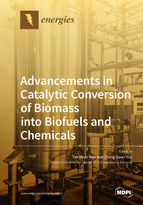Advancements in Catalytic Conversion of Biomass into Biofuels and Chemicals
A special issue of Energies (ISSN 1996-1073). This special issue belongs to the section "A4: Bio-Energy".
Deadline for manuscript submissions: closed (10 August 2020) | Viewed by 17811
Special Issue Editors
Interests: biofuel; bio-based product; biochemical; pretreatment; bioconversion process integration; biorefinery; bioprocessing
Special Issues, Collections and Topics in MDPI journals
Interests: biological/thermochemical conversion of biomass to fuels and chemicals; bio-based material application; elucidation of biomass and bio-product properties; development of lignocellulosic biorefinery
Special Issues, Collections and Topics in MDPI journals
Special Issue Information
Dear Colleagues,
Numerous efforts have been devoted to using biomass as a feedstock for the production of bio-based materials, biochemicals, and biofuels that reduce greenhouse gas emissions and dependence on conventional fossil resources.
Conversion strategies for the production of platform chemicals, building blocks, fine chemicals, and biofuels, include a wide range of processes, for example, chemical and mechanical pretreatment for improved carbohydrates production, fractionation of biomass into carbohydrates and lignin and their further conversions, microbial and enzymatic conversion of biomass into valuable products, direct catalytic conversion of biomass or its components into chemicals and fuels.
The goal of this Special Issue is to publish both recent innovative research results as well as review papers in the area of bioenergy and value-added chemicals from various feedstock through chemical and/or biological catalytic processes. Review and research papers on advances in the applications of carbohydrates and lignin components derived from biomass are also of interest.
If you would like to contribute a review paper, please contact one of the editors to discuss the relevance of the topic before submitting the manuscript.
Prof. Dr. Tae Hyun Kim
Prof. Dr. Chang Geun Yoo
Guest Editors
Manuscript Submission Information
Manuscripts should be submitted online at www.mdpi.com by registering and logging in to this website. Once you are registered, click here to go to the submission form. Manuscripts can be submitted until the deadline. All submissions that pass pre-check are peer-reviewed. Accepted papers will be published continuously in the journal (as soon as accepted) and will be listed together on the special issue website. Research articles, review articles as well as short communications are invited. For planned papers, a title and short abstract (about 100 words) can be sent to the Editorial Office for announcement on this website.
Submitted manuscripts should not have been published previously, nor be under consideration for publication elsewhere (except conference proceedings papers). All manuscripts are thoroughly refereed through a single-blind peer-review process. A guide for authors and other relevant information for submission of manuscripts is available on the Instructions for Authors page. Energies is an international peer-reviewed open access semimonthly journal published by MDPI.
Please visit the Instructions for Authors page before submitting a manuscript. The Article Processing Charge (APC) for publication in this open access journal is 2600 CHF (Swiss Francs). Submitted papers should be well formatted and use good English. Authors may use MDPI's English editing service prior to publication or during author revisions.
Keywords
- bioenergy
- bio-based product
- carbohydrates
- lignin
- catalytic conversion







